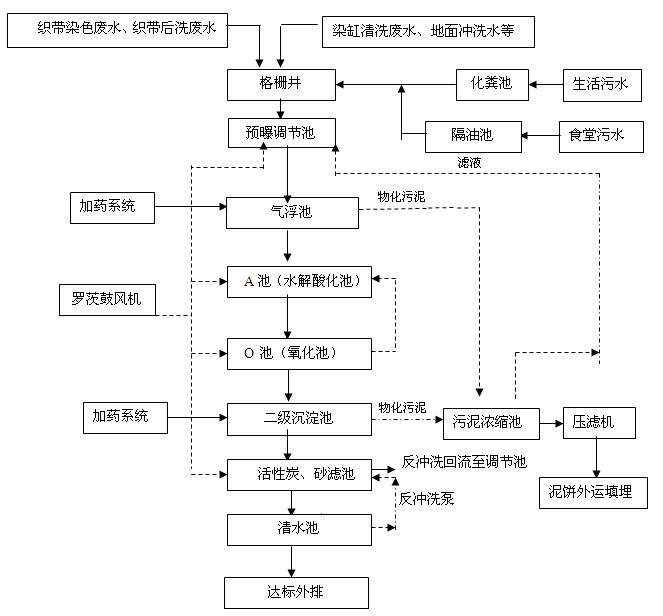Project Profile: Wenzhou Rui'an A Ribbon Co., Ltd. is a professional manufacturer of webbing tapes, color belts, adhesive tapes and special adhesive tapes. It is located in Panyu Industrial Zone, Ruian City. The company has advanced ribbon dyeing facilities and steaming process production technology. The printing and dyeing ribbon wastewater produced in the production process is complex in water quality, large in water volume, high in organic pollutant content, deep in color, large in alkalinity and pH value, and severe in water quality. . In addition to the advancement of the printing and dyeing technology of the webbing, the use of PVA pulp, new additives and other organic substances that are difficult to biodegrade into the wastewater is greatly increased, so that the environmental damage of the web printing and dyeing wastewater is greatly increased. In order to implement the national environmental protection policy and the requirements of the local environmental protection department, an environmental protection plan was formulated, and a new 2,000-ton/day sewage treatment project was established. Entrusted by it, our company (Ningbo Jingyuan Membrane Technology Co., Ltd.) conducted on-site inspection and water quality analysis of the sewage treatment project, combined with our company's experience in printing and dyeing wastewater treatment, designed and constructed the project.
| Name | Unit | Index value |
| CODcr | mg/l | ≤2000 |
| BOD5 | mg/l | ≤500 |
| pH | - | 5~8 |
| SS | mg/l | ≤300 |
| Chromaticity (dilution factor) | - | ≤200 |
After the wastewater is treated, it achieves the first-class emission standard superior to the “Dyeing and Finishing Industry Water Pollutant Emission Standard” (GB4287-1992). The specific indicators of the standard are as follows:
| Name | Unit | Index value |
| CODcr | mg/l | ≤100 |
| BOD5 | mg/l | ≤25 |
| pH | - | 6~9 |
| SS | mg/l | ≤70 |
| Chromaticity (dilution factor) | - | ≤40 |

Weaving dyeing wastewater from the production workshop, dyeing tank cleaning wastewater, webbing washing wastewater, ground mopping wastewater and domestic sewage in the living area are collected by the plant collection system into the grid collecting well to remove some large-diameter solid particles and fine-cut webbing. Hair, etc.
The wastewater passing through the grid system enters the uniform water quality and water volume in the pre-exposure adjustment tank, and then is lifted into the reaction gas floatation tank by the lift pump to remove a large amount of fine solid particles, some organic matter and unreacted dye particles, etc., and the reaction flotation tank is reduced as a pretreatment system. Subsequent biochemical load. The pretreated effluent flows into the hydrolysis acidification tank. The main function of the hydrolysis acidification tank is to degrade the macromolecular organic matter in the wastewater into small molecular substances, and the difficult biodegradable substances are converted into biodegradable substances. Meanwhile, the hydrolysis acidification tank has Good resistance to organic loads and toxic impacts; degradation of solid organics can reduce sludge volume. The water passing through the hydrolysis acidification tank flows into the aerobic pool, and is metabolized by aerobic bacteria perfushed on the filler in the aerobic pool, and is subjected to aerobic treatment to oxidize and decompose the pollutants in the water into CO2 and H2O, thereby completing a large amount of organic matter. After removal, a part of the biological contact oxidation tank effluent is returned to the water inlet of the hydrolysis acidification tank, and at the same time, another part is subjected to the dosing reaction to further remove SS and part of the organic matter, and the treated water flows into the secondary sedimentation tank to separate the mud water. The water separated by the muddy water of the secondary sedimentation tank flows into the sand filtration system to remove the SS from the secondary sedimentation tank. Finally, the water enters the clear water pool, and the water in the clear water pool also serves as the backwash water of the sand filter. The backwashed water is returned to the conditioning tank for reprocessing.

Scan It